Machine Learning and Unsupervised Learning #
Chapter 1 of Hull starts with a discussion of machine learning, data needs, and how to categorize different types of machine learning. Machine learning is a combination of statistics and computer science. It is a way to use data to make predictions. A lot of the machine learning math has been around a while, but really became useful with more data, more storage, and more computing power.
Machine learning and artificial intelligence are related.
Traditionally, economics and econometrics more specifically have been concerned with causality. Causality is a subtle, complicated idea. It is not the same as correlation. Causality is about understanding the mechanism behind a relationship. Machine learning is more about prediction. It is about using data to make predictions, and it does not (necessarily) care about the underlying mechanism. To understand the mechanism, we often want to have a theory.
Think about developing a drug. You want to understand how the drug works. You want to understand the biology. You want to know how it interacts with the body. You want to know how it interacts with other drugs. You want to know how it interacts with different people. If the drug does work, you want to understand why.
Machine learning is about patterns in data. It is traditionally about using data to make predictions. In practice, machine learning and causal inference is often used together now.
Finance is a tricky example of machine learning. We don’t have as much data as, say, image recognition. The images also don’t know that you are trying to categorize them, to predict them. The fact that someone is trying to predict a future stock price changes the stock price and affects the prediction process.
Of course, some areas of finance have more data than others. For example, if you are trying to understand the limit-order book and your trading costs, that’s more data than looking at quarterly accounting statements.
This is nice summary of how we are using machine learning in finance: https://papers.ssrn.com/sol3/papers.cfm?abstract_id=4501707. The authors are academics, but one of them also works at a hedge fund. The first chapter discusses some of the tensions between prediction and causality that I mention above.
Roughly speaking, there are two main types of machine learning:
Supervised learning: This is where you have a target variable. You are trying to predict something. You have a set of features and a target variable. You are trying to understand the relationship between the features and the target variable. You are trying to predict the target variable using the features.
Unsupervised learning: This is where you do not have a target variable. You are trying to understand the structure of the data. You are trying to find patterns in the data. You are trying to cluster the data.
There are others, but this is a helpful heuristic.
We’ll start with unsupervised learning below.
Unsupervised Learning #
These notes follow along with Chapter 2 of our Hull textbook. My notes are not meant to be comprehensive. Instead, I want to provide you with some additional resources and commentary on what is in this chapter.
As noted in Chapter 2,
… unsupervised learning is concerned with identifying patterns in data. The immediate objective is not to predict the value of a target variable. Instead, it is to understand the structure of data and find clusters.
Feature Scaling#
The chapter starts with a particular transformation of our data. We’ve already seen a bit about how to take our raw data and create new variables from it. This broad topic is called feature engineering. It is a crucial part of data analysis, as you are rarely taking raw data and using it to make a prediction or investigate a causal relationship.
Instead, you need to change your variables. Scale or normalize them. Create categories. Take logs. All to help with interpretation and create better models.
The purpose of feature scaling is to ensure that the features are given equal importance in a model. You’re trying to capture how different a variable is from its typical value and whether or not this relates to some other value, the one that you’re trying to predict.
The text discusses normalization. You’ve probably seen this calculation in your stats class.
where V is the value of an observation, \(\mu\) is the mean of all of the observations, and \(\sigma\) is the standard deviation of the values. This is called a Z-score normalization.
You can also do min-max scaling.
Finally, note that use of training set and validation set. We are going to start splitting our data up as we use machine learning techniques to make predictions. We use these data sets to build our model and, in particular, look for hyperparameters, a subject we’ll get to when discussing regression and logit in Chapter 3 of Hull. We’l also create a testing set where we take the trained model and see how well it predicts values using data we’ve pulled out and not used.
Hull points out that, when scaling your data, you should pull the means and standard deviations that you need from the training data. Then, you scale your testing data using the means and standard deviations from the training data. That way, you’re testing data never touches your training data. If you use the means and standard deviations from all of your data to scale your variables, then observations in your testing data set are altering observations in your training data set, and vice-versa.
Additional materials on feature engineering#
Here are some examples from Datacamp on feature engineering for a Kaggle competition. Again, this is all about variable transformation and, more generally, data engineering. For example, see the example on binning data? This is like when we created some categories for house sizes in our problem sets.
Here’s an entire book on feature engineering. It is a work in progress, but gives you a sense for the types of transformations that you can make and why you might want to make them.
The Feature Engineering book has a section on normalization.
K-means Algorithm#
Clustering is about grouping our data. How some observations like others? To do this, we are going to use the concept of a distance between observations. Are some observations closer to others, in some sense?
We are going to use Kmeans from scikit-learn.
Our text discusses Euclidean distance on pgs. 25 and 26. This is like measuring the length of a line, except that you can do this in any number of dimensions.
There is also the concept of a center of a cluster. Suppose that a certain set of observations is regarded as a cluster. The center is calculated by averaging the values of each of the features for the observations in the cluster.
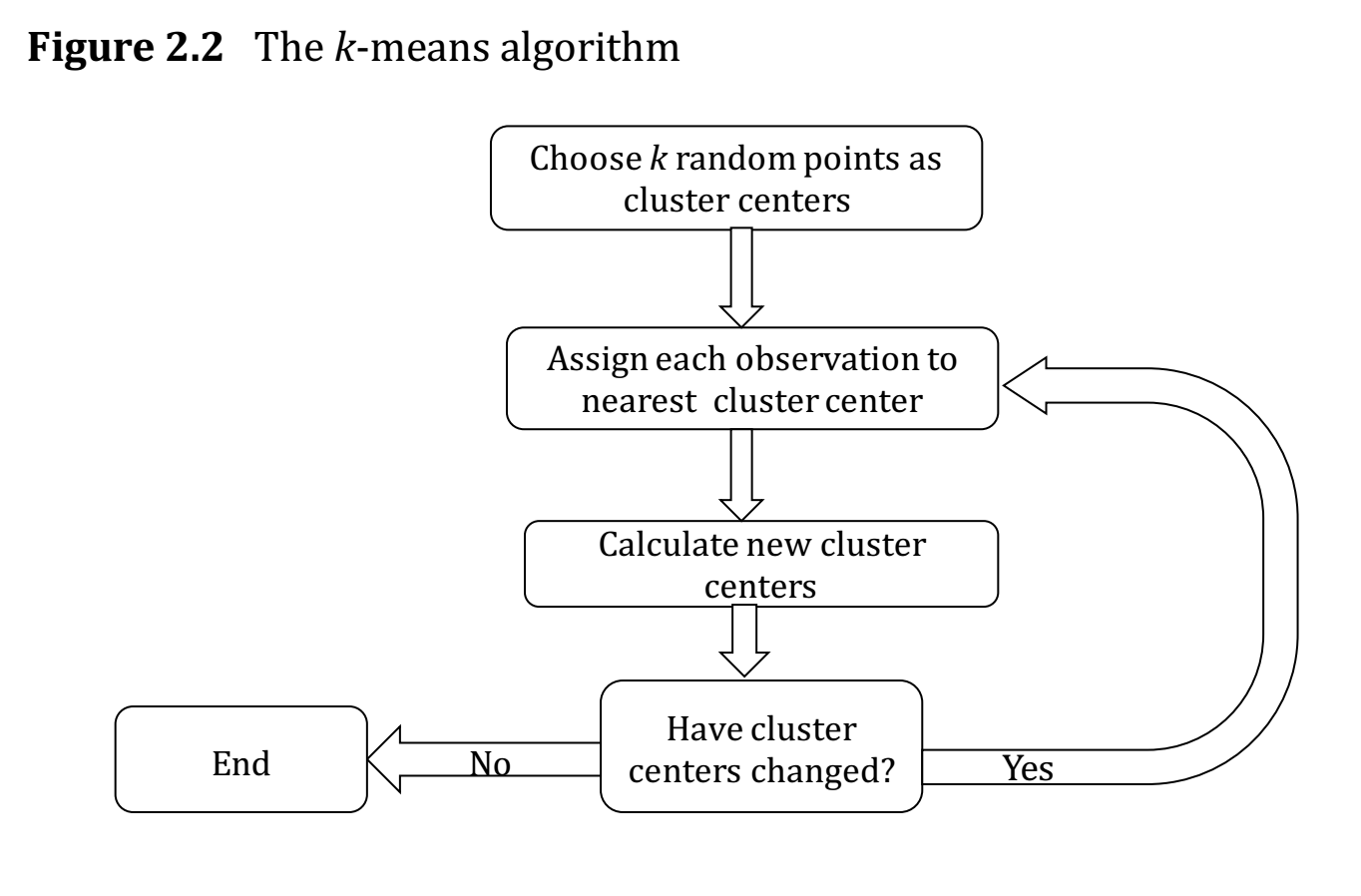
Fig. 46 How the algo works. From Hull, Chapter 2.#
How do you know if your clustering method is any good? A measure of the performance of a clustering algorithm is the within-cluster sum of squares, also known as the inertia. Define \(d_i\) as the distance of the ith observation from the center of the cluster to which it belongs.
The larger the inertia value, the worse the fit. Now, you can always get smaller inertia by adding more clusters. In fact, each observation could be its own cluster! But, that defeats the purpose. At some point, there’s an “optimal” number of clusters to try and divide your data into.
The example below will use the elbow method. Sometimes, there’s just a natural number of clusters that you’re looking for.
The text also discusses the silhouette method and gap method for choosing the optimal number of clusters. You want larger silhouette scores as you vary the number of clusters, k. You’ll also see an example of this below.
Finally, the text discusses the curse of dimensionality. Basically, as you have more and more features, forming clusters gets difficult. There are other ways to cluster your data, beyond Euclidean Distance. For example, the text mentions cosine similarity.
In the example below, we’ll start with four features. But, two of them are highly correlated, so we drop one. This is where looking at and understanding your data first is crucial.
An example with country risk#
I have re-created the code for this section below. We are now using the scikit-learn package. This is where the KMeans algo lives. I have uploaded the raw country risk data to our course Github page.
You can install scikit-learn with pip.
pip install -U scikit-learn
There is a bug with a package called threadpoolctl and scikit-learn. threadpoolctl needs to be version 3 or higher. This may not be an issue when running things in Github Codespaces, but it was on my local Mac install. You can get a later version by specifying the one that you want to install.
pip install threadpoolctl==3.2.0
# Our set-up
import pandas as pd
import numpy as np
# plotting packages
%matplotlib inline
from mpl_toolkits.mplot3d import Axes3D
import matplotlib.pyplot as plt
import matplotlib.cm as cm
import matplotlib.colors as clrs
# Kmeans algorithm from scikit-learn
from sklearn.cluster import KMeans
from sklearn.metrics import silhouette_samples, silhouette_score
from sklearn.preprocessing import StandardScaler
# load raw data
raw = pd.read_csv('https://raw.githubusercontent.com/aaiken1/fin-data-analysis-python/main/data/Country_Risk_2019_Data.csv')
# check the raw data
print("Size of the dataset (row, col): ", raw.shape)
print("\nFirst 5 rows\n", raw.head(n=5))
Size of the dataset (row, col): (121, 6)
First 5 rows
Country Abbrev Corruption Peace Legal GDP Growth
0 Albania AL 35 1.821 4.546 2.983
1 Algeria DZ 35 2.219 4.435 2.553
2 Argentina AR 45 1.989 5.087 -3.061
3 Armenia AM 42 2.294 4.812 6.000
4 Australia AU 77 1.419 8.363 1.713
Simple exploratory analysis#
Print summary statistics#
Note that all features have quite different variances, and Corruption and Legal are highly correlated.
# print summary statistics
print("\nSummary statistics\n", raw.describe())
print("\nCorrelation matrix\n", raw.corr())
Summary statistics
Corruption Peace Legal GDP Growth
count 121.000000 121.000000 121.000000 121.000000
mean 46.842975 2.001017 5.752529 2.657529
std 18.702499 0.461485 1.373932 2.563741
min 15.000000 1.072000 2.671000 -9.459000
25% 33.000000 1.699000 4.785000 1.249000
50% 41.000000 1.939000 5.455000 2.600000
75% 60.000000 2.294000 6.488000 4.000000
max 87.000000 3.369000 8.712000 7.800000
Correlation matrix
Corruption Peace Legal GDP Growth
Corruption 1.000000 -0.705002 0.938512 -0.123545
Peace -0.705002 1.000000 -0.662233 -0.004428
Legal 0.938512 -0.662233 1.000000 -0.150369
GDP Growth -0.123545 -0.004428 -0.150369 1.000000
Plot histogram#
Note that distributions for GDP Growth is quite skewed.
# plot histograms
plt.figure(1)
raw['Corruption'].plot(kind = 'hist', title = 'Corruption', alpha = 0.5)
plt.figure(2)
raw['Peace'].plot(kind = 'hist', title = 'Peace', alpha = 0.5)
plt.figure(3)
raw['Legal'].plot(kind = 'hist', title = 'Legal', alpha = 0.5)
plt.figure(4)
raw['GDP Growth'].plot(kind = 'hist', title = 'GDP Growth', alpha = 0.5)
plt.show()
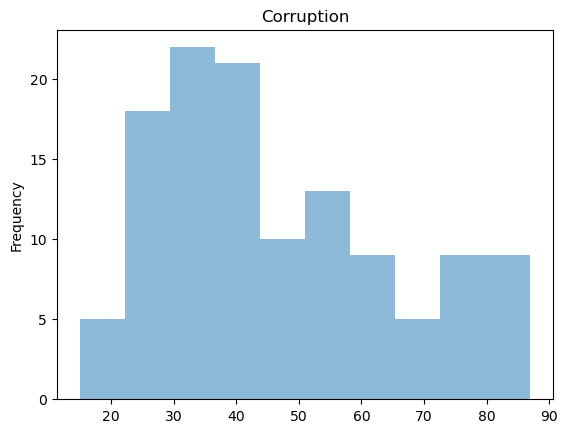
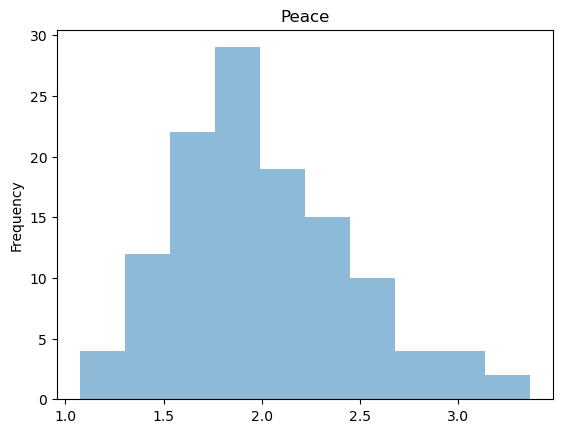
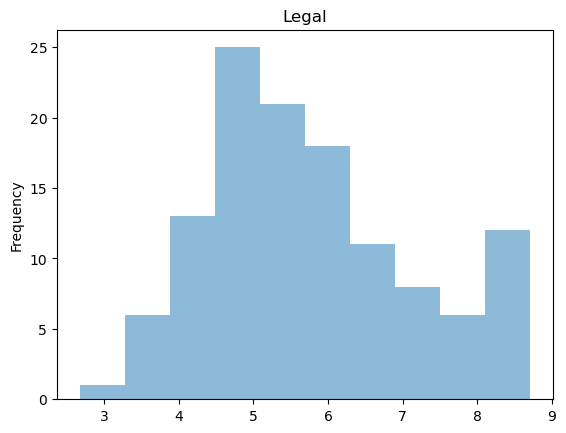
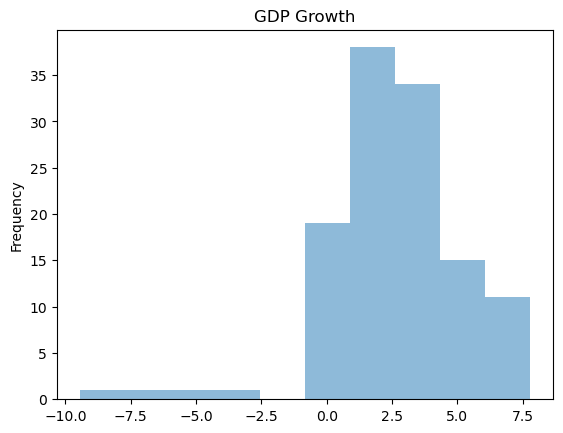
K means cluster#
Pick features & normalization#
Since Corruption and Legal are highly correlated, we drop the Corruption variable, i.e., we pick three features for this analysis, Peace, Legal and GDP Growth. Let’s normalize all the features, effectively making them equally weighted.
df_features = raw[['Peace', 'Legal', 'GDP Growth']]
df_features_scaled = (df_features - df_features.mean()) / df_features.std()
df_features_scaled.head(5)
| Peace | Legal | GDP Growth | |
|---|---|---|---|
| 0 | -0.390081 | -0.878158 | 0.126952 |
| 1 | 0.472352 | -0.958948 | -0.040772 |
| 2 | -0.026039 | -0.484397 | -2.230541 |
| 3 | 0.634871 | -0.684553 | 1.303747 |
| 4 | -1.261182 | 1.900001 | -0.368418 |
I’ve included some code to drop missing values, just in case. Kmeans doesn’t run if any row has a missing value. Of course, if there were missing values, you’d want to understand why.
df_features_scaled = df_features_scaled.dropna()
df_features_scaled.info()
<class 'pandas.core.frame.DataFrame'>
RangeIndex: 121 entries, 0 to 120
Data columns (total 3 columns):
# Column Non-Null Count Dtype
--- ------ -------------- -----
0 Peace 121 non-null float64
1 Legal 121 non-null float64
2 GDP Growth 121 non-null float64
dtypes: float64(3)
memory usage: 3.0 KB
See, no missing values. Still 121 observations.
scikit-learn comes with built-in scalers. Here, I’m scaling the feature data in a similar manner. The output is an array, not a DataFrame.
df_features_scaled2 = StandardScaler().fit_transform(df_features)
df_features_scaled2[:5,:3]
array([[-0.39170288, -0.88180929, 0.12747948],
[ 0.47431618, -0.96293527, -0.04094156],
[-0.02614709, -0.48641154, -2.23981529],
[ 0.63751073, -0.68739931, 1.30916848],
[-1.26642564, 1.90790093, -0.3699501 ]])
Perform elbow method#
This is a way to visualize how good the fit is. There are decreasing returns to adding more clusters. The marginal gain of adding one cluster dropped quite a bit from k=3 to k=4. We will choose k=3 (not clear cut though).
Ref. Determining the number of clusters in a dataset.
# https://stackoverflow.com/questions/41540751/sklearn-kmeans-equivalent-of-elbow-method
Ks = range(1, 10)
inertia = [KMeans(i).fit(df_features_scaled).inertia_ for i in Ks]
fig = plt.figure()
plt.plot(Ks, inertia, '-bo')
plt.xlabel('Number of clusters')
plt.ylabel('Inertia (within-cluster sum of squares)')
plt.show()

K means with k=3#
Each country is getting labeled now. There are three categories (k=3).
k = 3
kmeans = KMeans(n_clusters=k, random_state=1)
kmeans.fit(df_features_scaled)
# print inertia & cluster center
print("inertia for k=3 is", kmeans.inertia_)
print("cluster centers: ", kmeans.cluster_centers_)
# take a quick look at the result
y = kmeans.labels_
print("cluster labels: ", y)
inertia for k=3 is 161.2893804348309
cluster centers: [[ 1.22973303 -0.68496051 -0.94125294]
[ 0.16803028 -0.59729967 0.69048743]
[-0.85097477 1.02149992 -0.23897931]]
cluster labels: [1 1 0 1 2 2 1 0 1 2 1 1 1 2 0 1 0 1 2 0 2 1 0 2 1 2 2 0 2 1 0 1 1 2 1 2 2
1 1 2 1 1 1 1 2 2 1 1 0 2 0 2 2 2 2 1 1 2 2 2 0 0 2 1 1 2 1 1 2 0 1 1 1 1
1 2 2 0 0 2 2 0 1 0 1 1 2 2 2 2 0 1 0 1 1 1 2 2 2 0 2 1 2 2 2 1 1 1 0 1 0
1 0 2 2 2 2 1 0 1 0]
Visualize the result (3D plot)#
Three groups of countries, clustered along three dimensions of risk.
Before you make any graph, think about what you want to show and why. Sketch it on a piece of paper. You can use Chat GPT to help you with syntax once you know what you want.
# set up the color
norm = clrs.Normalize(vmin=0.,vmax=y.max() + 0.8)
cmap = cm.viridis
fig = plt.figure()
ax = fig.add_subplot(111, projection='3d')
ax.scatter(df_features_scaled.iloc[:,0], df_features_scaled.iloc[:,1], df_features_scaled.iloc[:,2], c=cmap(norm(y)), marker='o')
centers = kmeans.cluster_centers_
ax.scatter(centers[:, 0], centers[:, 1], c='black', s=100, alpha=0.5)
ax.set_xlabel('Peace')
ax.set_ylabel('Legal')
ax.set_zlabel('GDP Growth')
plt.show()
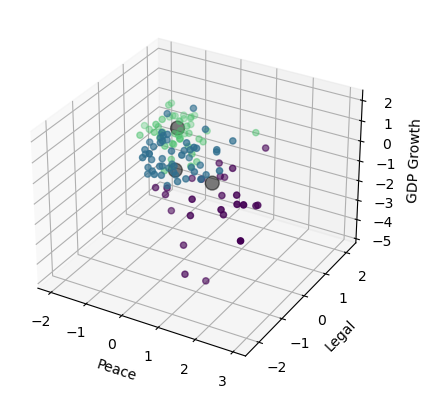
%matplotlib inline
import matplotlib.pyplot as plt
figs = [(0, 1), (0, 2), (1, 2)]
labels = ['Peace', 'Legal', 'GDP Growth']
for i in range(3):
fig = plt.figure(i)
plt.scatter(df_features_scaled.iloc[:,figs[i][0]], df_features_scaled.iloc[:,figs[i][1]], c=cmap(norm(y)), s=50)
plt.scatter(centers[:, figs[i][0]], centers[:, figs[i][1]], c='black', s=200, alpha=0.5)
plt.xlabel(labels[figs[i][0]])
plt.ylabel(labels[figs[i][1]])
plt.show()


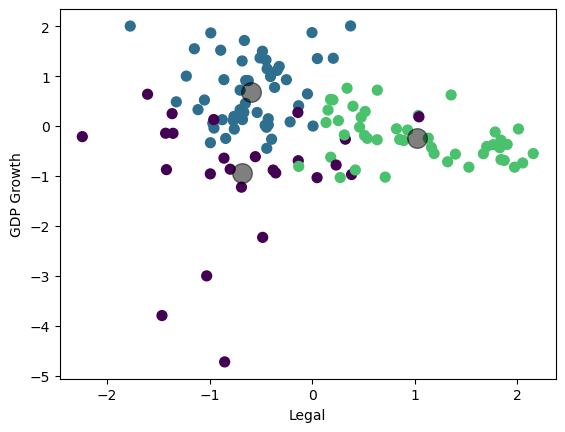
Visualize the result (3 2D plots)#
Let’s plot country abbreviations instead of dots. By being careful with our graphic design, we can show dimensionality a variety of ways.
%matplotlib inline
import matplotlib.pyplot as plt
figs = [(0, 1), (0, 2), (1, 2)]
labels = ['Peace', 'Legal', 'GDP Growth']
colors = ['blue','green', 'red']
for i in range(3):
fig = plt.figure(i, figsize=(8, 8))
x_1 = figs[i][0]
x_2 = figs[i][1]
plt.scatter(df_features_scaled.iloc[:, x_1], df_features_scaled.iloc[:, x_2], c=y, s=0, alpha=0)
plt.scatter(centers[:, x_1], centers[:, x_2], c='black', s=200, alpha=0.5)
for j in range(df_features_scaled.shape[0]):
plt.text(df_features_scaled.iloc[j, x_1], df_features_scaled.iloc[j, x_2], raw['Abbrev'].iloc[j],
color=colors[y[j]], weight='semibold', horizontalalignment = 'center', verticalalignment = 'center')
plt.xlabel(labels[x_1])
plt.ylabel(labels[x_2])
plt.show()



List the result#
Let’s see how every country got classified. Who are in the same groups? Does this grouping make sense?
result = pd.DataFrame({'Country':raw['Country'], 'Abbrev':raw['Abbrev'], 'Label':y})
with pd.option_context('display.max_rows', None, 'display.max_columns', 3):
print(result.sort_values('Label'))
Country Abbrev Label
60 Lebanon LB 0
30 Ecuador EC 0
48 Iran IR 0
50 Israel IL 0
61 Liberia LR 0
69 Mexico MX 0
77 Nicaragua NI 0
78 Nigeria NG 0
27 Democratic Republic of Congo CD 0
81 Pakistan PK 0
90 Russia RU 0
92 Saudi Arabia SA 0
99 South Africa ZA 0
108 Trinidad and Tobago TT 0
110 Turkey TR 0
112 Ukraine UA 0
118 Yemen YE 0
83 Paraguay PY 0
22 Colombia CO 0
120 Zimbabwe ZW 0
7 Bahrain BH 0
2 Argentina AR 0
14 Brazil BR 0
19 Chad TD 0
16 Burundi BI 0
82 Panama PA 1
10 Benin BJ 1
11 Bolivia BO 1
74 Nepal NP 1
73 Mozambique MZ 1
71 Montenegro ME 1
8 Bangladesh BD 1
12 Bosnia and Herzegovina BA 1
67 Mauritania MR 1
66 Mali ML 1
64 Malawi MW 1
72 Morocco MA 1
84 Peru PE 1
70 Moldova FM 1
63 Madagascar MG 1
1 Algeria DZ 1
117 Vietnam VI 1
111 Uganda UG 1
3 Armenia AM 1
109 Tunisia TN 1
107 The FYR of Macedonia MK 1
85 Philippines PH 1
106 Thailand TH 1
101 Sri Lanka LK 1
95 Sierra Leone SL 1
94 Serbia RS 1
93 Senegal SN 1
6 Azerbaijan AZ 1
91 Rwanda RW 1
105 Tanzania TZ 1
119 Zambia ZM 1
0 Albania AL 1
29 Dominican Republic DO 1
37 Gabon GA 1
56 Kenya KE 1
38 Georgia GE 1
40 Ghana GH 1
41 Greece GR 1
31 Egypt EG 1
42 Guatemala GT 1
43 Honduras HN 1
32 El Salvador SV 1
17 Cameroon CM 1
46 India IN 1
47 Indonesia ID 1
34 Ethiopia ET 1
21 China CN 1
24 Croatia HR 1
55 Kazakhstan KZ 1
15 Bulgaria BG 1
4 Australia AU 2
96 Singapore SG 2
97 Slovakia SK 2
18 Canada CA 2
98 Slovenia SI 2
5 Austria AT 2
100 Spain ES 2
116 Uruguay UY 2
115 United States US 2
102 Sweden SE 2
103 Switzerland CH 2
113 United Arab Emirates AE 2
23 Costa Rica CR 2
104 Taiwan SY 2
28 Denmark DK 2
25 Cyprus CY 2
26 Czech Republic CZ 2
114 United Kingdom GB 2
57 Korea (South) KI 2
88 Qatar QA 2
35 Finland FI 2
58 Kuwait KW 2
59 Latvia LV 2
13 Botswana BW 2
62 Lithuania LT 2
54 Jordan JO 2
53 Japan JP 2
65 Malaysia MY 2
52 Jamaica JM 2
51 Italy IT 2
68 Mauritius MU 2
49 Ireland IE 2
45 Iceland IS 2
44 Hungary HU 2
75 Netherlands NL 2
76 New Zealand NZ 2
79 Norway NO 2
80 Oman OM 2
9 Belgium BE 2
39 Germany DE 2
86 Poland PL 2
87 Portugal PT 2
89 Romania RO 2
36 France FR 2
33 Estonia EE 2
20 Chile CL 2
Silhouette Scores#
A larger score is better. Note how scikit-learn has these features built-in. We don’t have to do the calculation ourselves.
# Silhouette Analysis
range_n_clusters=[2,3,4,5,6,7,8,9,10]
for n_clusters in range_n_clusters:
clusterer=KMeans(n_clusters=n_clusters, random_state=1)
cluster_labels=clusterer.fit_predict(df_features_scaled)
silhouette_avg=silhouette_score(df_features_scaled,cluster_labels)
print("For n_clusters=", n_clusters,
"The average silhouette_score is :", silhouette_avg)
For n_clusters= 2 The average silhouette_score is : 0.35091395238521605
For n_clusters= 3 The average silhouette_score is : 0.35287972873953516
For n_clusters= 4 The average silhouette_score is : 0.3162677855568406
For n_clusters= 5 The average silhouette_score is : 0.2769522059777643
For n_clusters= 6 The average silhouette_score is : 0.33582504378732997
For n_clusters= 7 The average silhouette_score is : 0.311002099095008
For n_clusters= 8 The average silhouette_score is : 0.35010275097023785
For n_clusters= 9 The average silhouette_score is : 0.3459688066178027
For n_clusters= 10 The average silhouette_score is : 0.31726760014278527
Principal Component Analysis (PCA)#
Chapter 2 ends with some alternative clustering methods, including principal component analysis (PCA).
PCA takes the data features and creates factors from the data that are uncorrelated with each other. From pg. 42:
PCA works best on normalized data. The first factor accounts for as much of the variability in the data as possible. Each succeeding factor then accounts for as much of the remaining variability in the data subject to the condition that it is uncorrelated to preceding factors. The quantity of a particular factor in a particular observation is the factor score.
You can read more about how to do this with Scikit-learn PCA.
What is PCA really doing? Well, you need some matrix algebra for that. Here’s another explainer, with the bare-minimum of math.
This video was recommended by QuantyMacro.
Let’s start with some simple PCA code using our scaled features.
from sklearn.decomposition import PCA
df_features_scaled_pca = raw[['Corruption', 'Peace', 'Legal', 'GDP Growth']]
df_features_scaled_pca = (df_features_scaled_pca - df_features_scaled_pca.mean()) / df_features_scaled_pca.std()
df_features_scaled_pca.head(5)
| Corruption | Peace | Legal | GDP Growth | |
|---|---|---|---|---|
| 0 | -0.633230 | -0.390081 | -0.878158 | 0.126952 |
| 1 | -0.633230 | 0.472352 | -0.958948 | -0.040772 |
| 2 | -0.098542 | -0.026039 | -0.484397 | -2.230541 |
| 3 | -0.258948 | 0.634871 | -0.684553 | 1.303747 |
| 4 | 1.612460 | -1.261182 | 1.900001 | -0.368418 |
The code below defines an object called pca. We then apply the method .fit to this object using the full set of scaled data - I didn’t drop Corruption this time.
pca = PCA(n_components=4)
pca.fit(df_features_scaled_pca)
PCA(n_components=4)In a Jupyter environment, please rerun this cell to show the HTML representation or trust the notebook.
On GitHub, the HTML representation is unable to render, please try loading this page with nbviewer.org.
PCA(n_components=4)
I can then look at the output. This is called the attributes of the model.
For example, pca.components prints the four principle components for the four features in our data. These match up with pg. 44 of the text. Note how the signs can be reversed and it doesn’t matter, as Hull mentions.
print(pca.explained_variance_ratio_)
print(pca.singular_values_)
print(pca.components_)
[0.64020312 0.25059185 0.09438808 0.01481695]
[17.52990289 10.96741031 6.73099393 2.66685887]
[[-0.60188457 0.52361257 -0.59403386 0.10338576]
[-0.01512074 0.20084677 0.02192676 -0.97926051]
[ 0.32824929 0.82539386 0.42519586 0.17374078]
[ 0.72784526 0.06492634 -0.68253313 -0.01320492]]
Hull notes when PCA is used. In particular, we can use it to shrink the number of features in our models. It can combine features together.
PCA is sometimes used in supervised learning as well as unsupervised learning. We can use it to replace a long list of features by a much smaller list of manufactured features derived from a PCA. The manufactured features are chosen so that they account for most of the variability in the data we are using for prediction and have the nice property that they are uncorrelated.
In other words, PCA can be used to take thousands or millions of columns (variables or features) and reduce them to just a few that contain the important variation in our data.
One example, often cited, is using PCA to shrink the number of factors in a variance-covariance matrix. From the linked lecture note from the University of Washington:
Principal component analysis is a tool that is commonly used in exploratory data analysis and predictive analysis, which seeks to explain the bulk of the variation in demeaned data in terms of a smaller number of uncorrelated derived variables (principal components).


